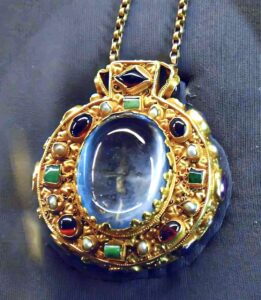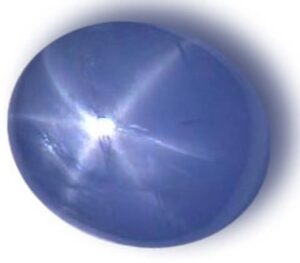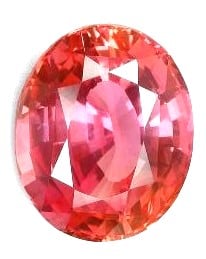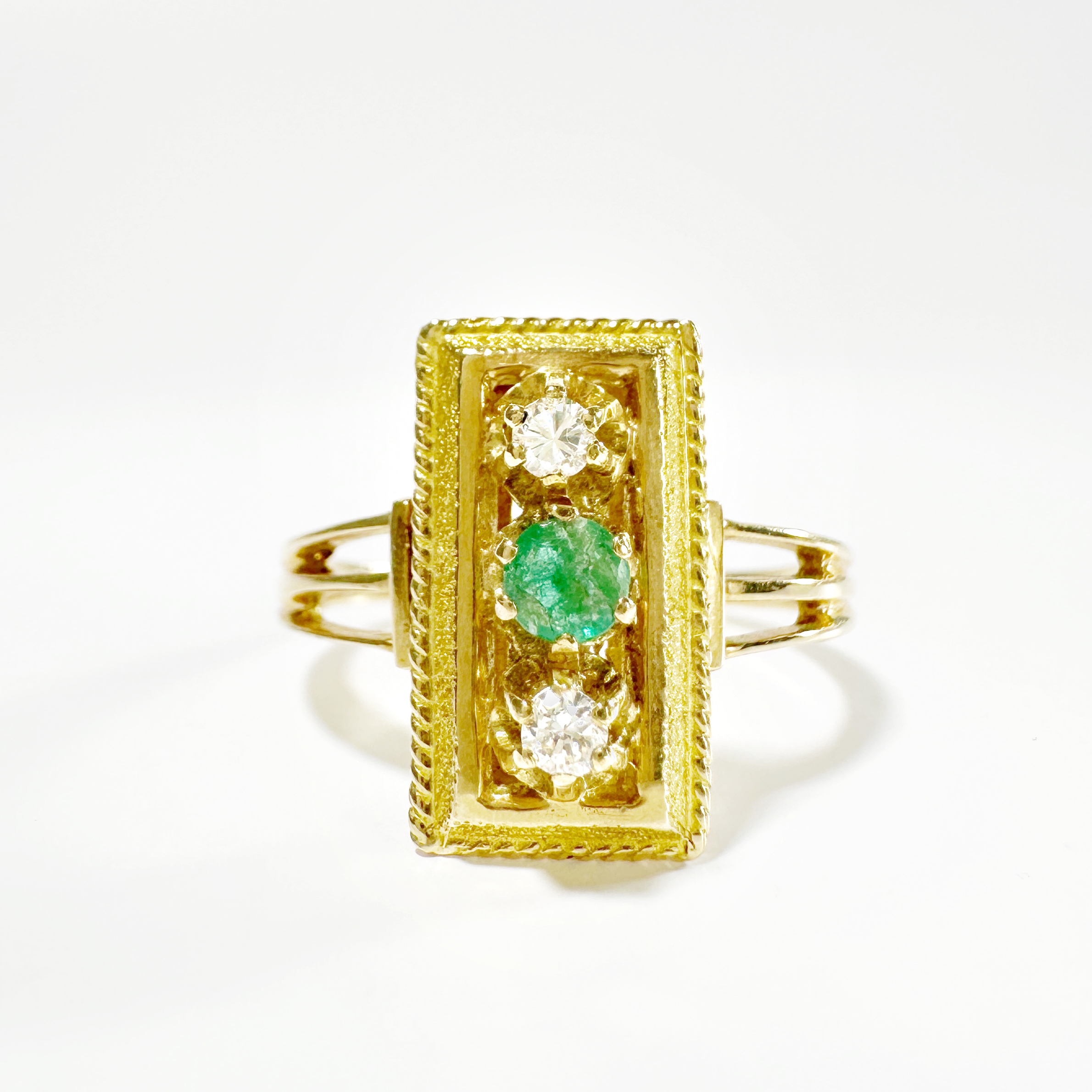Stone of the month of September, sapphire has captivated since ancient times for its multiple shades of blue, even if its other colors are lesser known but varied. We often forget that rubies are none other than red sapphires! Gem of choice for engagement rings, sapphire bewitches us for more than one reason that we will explore in this article.
HISTORY OF SAPPHIRES
The name sapphire comes from the Greek sappheiros or “blue colored stone” or from the Hebrew sappir or “the most beautiful thing”. For a long time, this Greek term referred to lapis lazuli.
The use and trade of this gem from Sri Lanka and exploited by the Greeks and Romans, dates back to the fifth century BC.
 The celestial color of sapphire earned it to be associated by the Persians with heaven and by extension, with divinity. It is for this reason that this delicate stone adorns the jewels of many crowned heads.
The celestial color of sapphire earned it to be associated by the Persians with heaven and by extension, with divinity. It is for this reason that this delicate stone adorns the jewels of many crowned heads.
One of the most famous sapphire jewels in history is surely Charlemagne’s Talisman. The latter was decorated with a superb blue sapphire cut in “pain de sucre”. This exceptional gem of more than 190 carats and coming from Ceylon would be the largest sapphire known until the 17th century. Its origin is attributed to a gift from the caliph of the Arabian Nights, Harun Al-Rashid. This jewel can now be admired at the Palais du Tau in Reims, France.
MAIN DEPOSITS OF SAPPHIRES IN THE WORLD
Sapphires are the result of extremely special geological conditions. While blue sapphires traditionally come from Sri Lanka and Burma (Mogok), they are produced in other countries, including Madagascar, Thailand, Vietnam, India, Cambodia (Pailin), China, Kenya, Laos, Nigeria, Tanzania, the United States (Montana) and Canada.
Sapphires of Burma
Burma, (now called Myanmar), is the country that is home to some of the most sought-after sapphires in the world. The most famous valley in the country for the extraction of precious stones, which is still done in an artisanal way, is the Mogok Valley in the Mandalay region. Despite the beauty of the gems, intensive research has almost exhausted the deposits and there are only a few Burmese sapphires on the world market.
The sapphires of Madagascar
Main producer of pink sapphires, Madagascar keeps on its soil very beautiful specimens of blue sapphires. Once heated, these can obtain an intense blue similar to that of Burmese sapphires. The recent discovery of gemstones has generated a gigantic exodus in the region where tens of thousands of people have flocked from all over the country to try their luck.
Sapphires of Sri Lanka
Like all other precious stones, sapphires are not all jewelry quality. Nevertheless, Sri Lanka has the world’s largest concentration of gem-quality stones. Ceylon Sapphire is one of the essential blue Sapphire thanks to the most balanced shades of blue of all varieties. In particular, we can find AAA quality gems, meaning that it has a very intense color and no inclusions visible to the naked eye.
Sapphires from India
Better known as Kashmir sapphire, they are mined in this mountainous region of northwestern India at more than 4000 meters above sea level. Exploitation is therefore only possible for a few weeks a year and most of the deposits are now sterile. Kashmir sapphires showcase an intense blue with shades of purple that make them unique.
Sapphires from Thailand
These can come from several mining sites in the country. Also known as Siamese sapphire, they have a frank blue color often dark. This aspect can be improved through heat treatment.
Canada’s Sapphires
The production of these Canadian sapphires, like that of Montana in the United States, is quite anecdotal. The stones, sometimes of good size, are too opaque or have too many inclusions to be of jewelry quality. In the same vein, we find Auvergne sapphires, which have an opaque blue color pulling slightly on the green.
COMPOSITION OF SAPPHIRE
Sapphire is one of the four gemstones along with diamond, ruby and emerald. It is a variety of corundum existing in several colors, except red which is designated only by the term “ruby”.
The hardness of sapphire is very high: 9 out of 10 on the Mohs scale the hardest stone after diamond.
 The origin of the stone is volcanic and forms between 20 and 60 km deep, and it is the magmatic upwellings that bring the stones to the surface. Unlike emeralds, whose geographical and geological location of extraction can be determined, chemical analysis of sapphires reveals only their geological origin.
The origin of the stone is volcanic and forms between 20 and 60 km deep, and it is the magmatic upwellings that bring the stones to the surface. Unlike emeralds, whose geographical and geological location of extraction can be determined, chemical analysis of sapphires reveals only their geological origin.
Thanks to the work of the French chemist Auguste Verneuil, we know how to produce synthetic sapphires in the laboratory since the beginning of the twentieth century. These synthetic stones are chemically and physically identical to natural stone. Synthetic sapphires are scratch resistant, hence their use to make watch glasses or camera lenses, lasers ….
THE COLORS OF SAPPHIRE
As a general rule, when using the term “sapphire“, we are referring to corundum of blue color. But in reality, sapphire also exists in pink, yellow, orange, purple, green or black. Colorless sapphires, called leukosapphires, are visually similar to white diamonds.
The most sought-after best-known variety throughout history, however, is blue sapphire.
In addition, the rarest and now coveted sapphire is called Padparadja or Padparadscha, pink-purplish or pink-orange in color.
 Another feature of sapphire is the presence of asterism on the surface of the stone, that is, a 6-pointed star pattern. This manifestation is due to the penetration of light into inclusions called rutile needles. To highlight this characteristic, the size of the cabochon gem is the most widespread.
Another feature of sapphire is the presence of asterism on the surface of the stone, that is, a 6-pointed star pattern. This manifestation is due to the penetration of light into inclusions called rutile needles. To highlight this characteristic, the size of the cabochon gem is the most widespread.
Sapphires with an asterism cannot be treated by heat, as this treatment would cause this characteristic to disappear. This is one of the reasons why sapphires with asterism are often opaque or milky.
SAPPHIRE SYMBOLISM
As is the case with all the most famous gemstones, blue sapphire is present in many mythological stories.
According to tradition, sapphire symbolizes fidelity, truth, nobility and the link with heaven, therefore divinity. This symbol of fidelity, combined with its hardness, makes sapphire a stone of choice for engagement rings.
 It is also the stone that adorns two of the most famous engagement rings in history:
It is also the stone that adorns two of the most famous engagement rings in history:
The first is the Toi et Moi ring offered by Napoleon Bonaparte to Joséphine de Beauharnais. The latter was decorated with a pear-cut sapphire as a symbol of loyalty, and a diamond of the same size as a symbol of eternity.
The second ring was the one given by Prince Charles to Diana in 1981. The now iconic ring is a marquise ring set with a deep blue 12-carat oval Ceylon sapphire sapphire surrounded by fourteen diamonds.
Explore our selection of vintage jewelry set with sapphires here!







